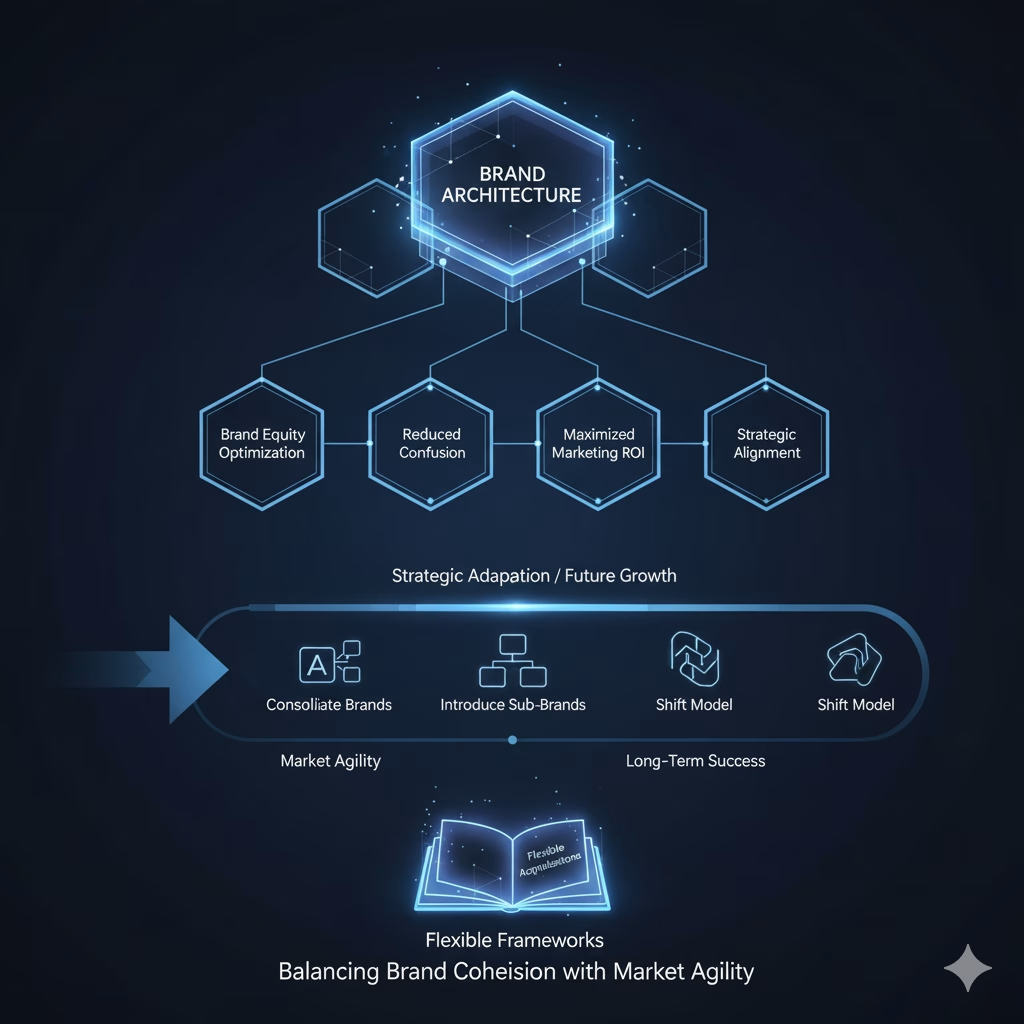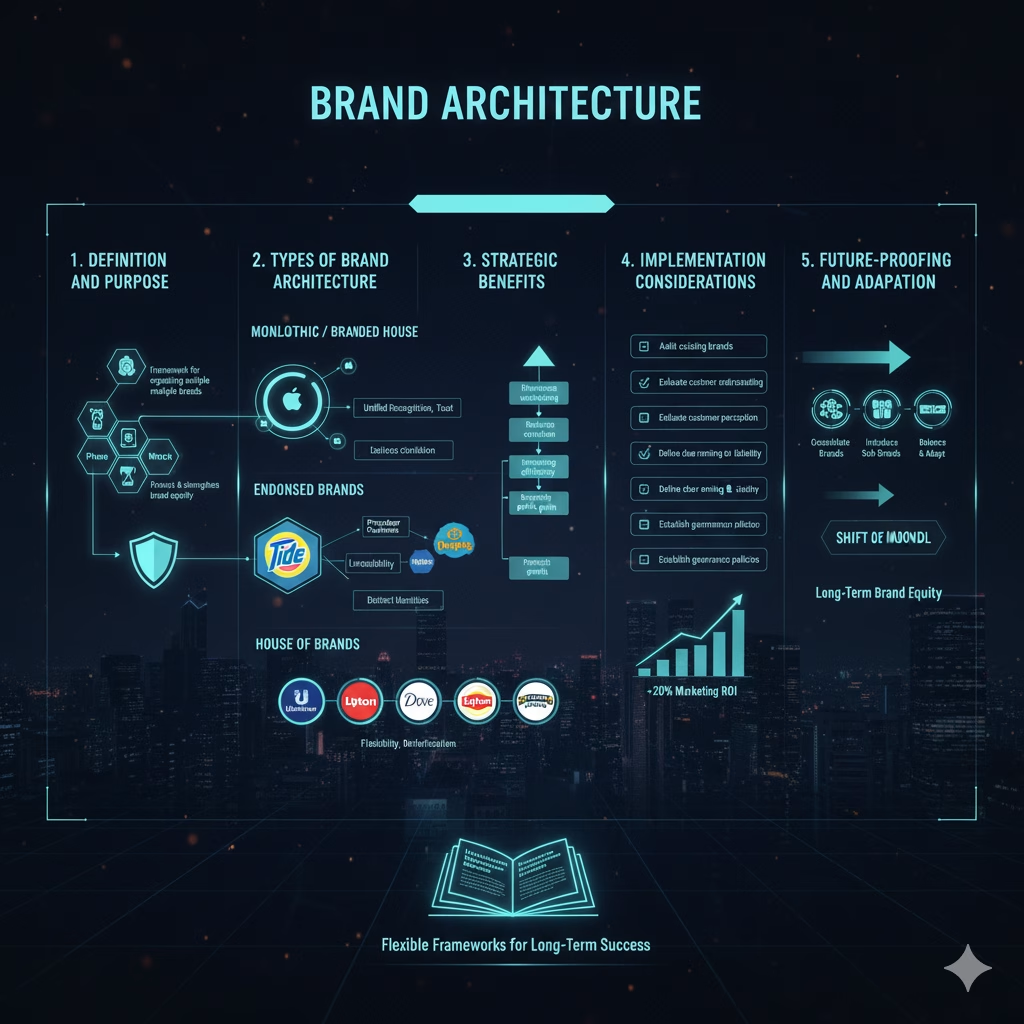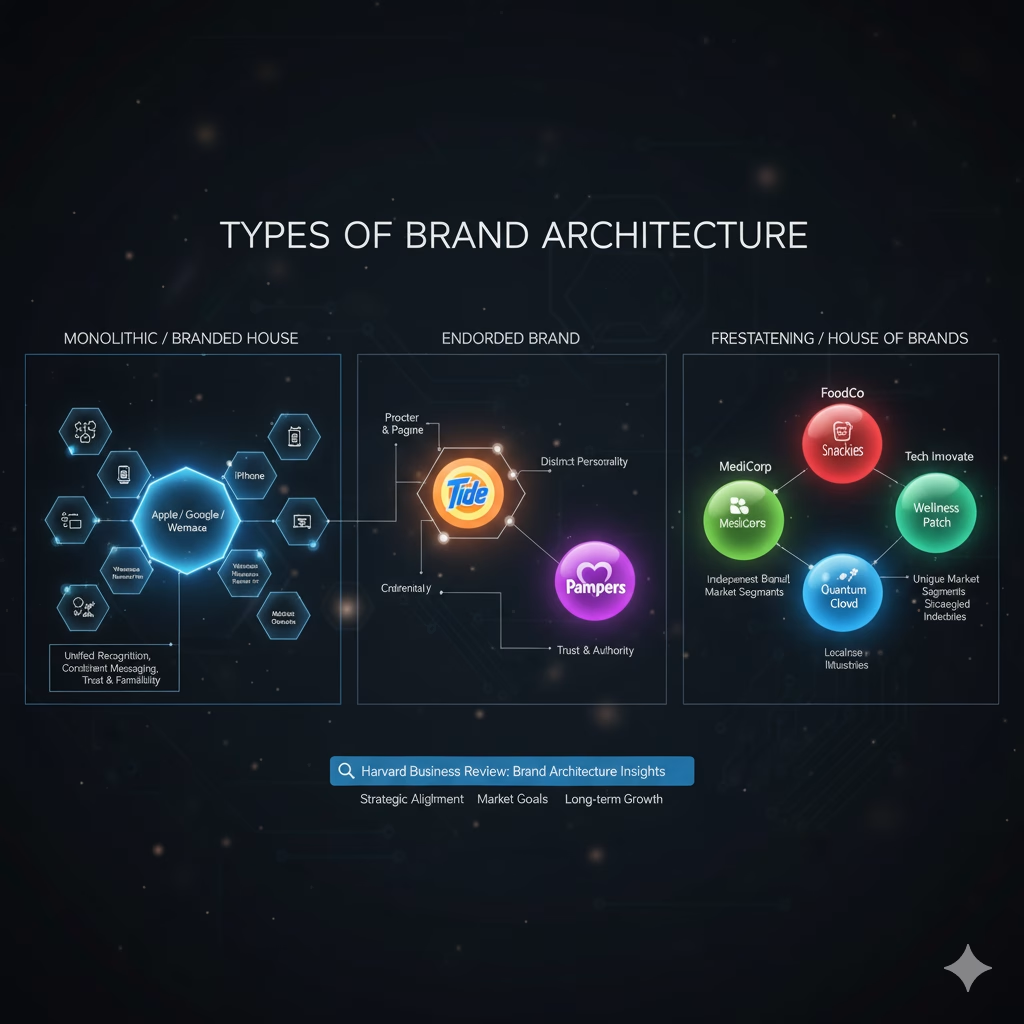Brand architecture defines the structural framework through which a company organizes, communicates, and manages its collection of brands, products, or services. It establishes clear relationships among multiple brand entities, ensuring consistency, clarity, and strategic alignment. Effective brand architecture allows businesses to optimize brand equity, reduce confusion, and maximize the impact of marketing investments.
Brand architecture is not static. Businesses should design flexible frameworks that accommodate future growth, innovation, and acquisitions. Strategic adaptation may involve consolidating brands, introducing sub-brands, or shifting to a different architectural model to meet changing customer expectations or competitive pressures. Long-term success requires a proactive approach that balances brand cohesion with market agility.

- 1. Definition and Purpose
- Framework for organizing multiple brands, products, or services.
- Clarifies relationships between brands and sub-brands.
- Protects and strengthens overall brand equity.
- 2. Types of Brand Architecture
- Monolithic / Branded House
- Single master brand used for all products and services.
- Reinforces brand recognition and trust.
- Endorsed Brands
- Independent brands endorsed or supported by a master brand.
- Leverages credibility while maintaining distinct identities.
- House of Brands
- Collection of independent brands with minimal visible connection.
- Allows flexibility, diversification, and market-specific positioning.
- Monolithic / Branded House

- 3. Strategic Benefits
- Enhances customer understanding and reduces confusion.
- Increases marketing efficiency and consistent messaging.
- Supports portfolio growth, product launches, and acquisitions.
- Prevents brand dilution and protects equity.
- 4. Implementation Considerations
- Audit existing brands and identify overlaps.
- Evaluate customer perception, loyalty, and market alignment.
- Define clear naming conventions, logos, visual identity, and messaging rules.
- Establish governance policies for brand management.

- 5. Future-Proofing and Adaptation
- Design flexible structures for growth, innovation, and acquisitions.
- Regularly review architecture to adapt to market or strategy changes.
- Balance cohesion with flexibility for long-term brand equity.
DEVELOPING COMPANY BRAND ARCHITECTURE
Brand architecture represents the blueprint for how a company organizes, presents, and connects its various brands, sub-brands, products, and services in a coherent and strategic way. It is the foundation upon which customer perception, loyalty, and recognition are built. Without a clear structure, brands risk confusion, diluted messaging, and weakened brand equity, which can lead to lost revenue and market positioning challenges. Effective brand architecture defines the relationships between the corporate brand, product lines, service offerings, and any endorsed or independent sub-brands, ensuring that every communication reinforces the overall brand promise. According to McKinsey & Company, companies that implement structured brand hierarchies experience higher customer recognition, increased trust, and measurable performance advantages compared to competitors without clearly defined brand relationships. By clearly mapping how each product or service connects to the core identity, organizations can make informed decisions about marketing spend, brand extensions, and positioning strategies.

There are several types of brand architecture, each serving a different strategic purpose and catering to diverse business needs. The monolithic or branded house model emphasizes a single dominant brand that extends across all products and services, providing unified recognition and consistent messaging. This model is exemplified by global brands such as Apple or Google, where every product carries the parent brand identity, ensuring immediate trust and familiarity. Companies like Wemaxa apply similar principles in their service tiers, making it easier for clients to understand offerings, navigate choices, and perceive value across the portfolio. The endorsed brand model, on the other hand, balances independence with credibility: sub-brands maintain their distinct personality while leveraging the reputation of the parent brand for trust and authority. Procter & Gamble’s portfolio demonstrates this effectively, where individual brands like Tide or Pampers benefit from P&G’s overarching credibility. Lastly, the freestanding or house of brands model allows each brand to operate independently, often targeting unique market segments without diluting the corporate identity. This is particularly advantageous for companies entering diverse industries or global markets, where localized branding strategies are essential. Understanding the strategic implications of each type enables businesses to align architecture with market goals, brand positioning, and long-term growth plans. For further insights, see Harvard Business Review on Brand Architecture.

Beyond structural considerations, brand architecture significantly impacts operational efficiency, marketing performance, and overall corporate strategy. When a company has a clear architectural framework, internal teams can make faster decisions regarding product launches, cross-promotional campaigns, and digital content creation. Marketing messages become more coherent and cost-effective, as overlapping campaigns are minimized and assets can be reused across related brands. Companies lacking clarity in architecture often face redundancy, confusing messaging, and wasted resources, leading to diminished brand value. Research indicates that consistent brand frameworks can enhance marketing ROI by over 20%, as cohesive visual identity, messaging, and promotional strategies reinforce recognition and recall. Platforms like Wemaxa branding services assist organizations in defining and executing these frameworks, from portfolio mapping to launch strategy, ensuring that every touchpoint strengthens the brand narrative and resonates with target audiences. Moreover, architectural clarity simplifies mergers, acquisitions, and expansions, as stakeholders can understand which brands to retain, consolidate, or rebrand for optimal portfolio health.
In the digital era, brand architecture also intersects with search engine optimization (SEO), content marketing, and social media strategy. Properly structured brands allow search engines to understand hierarchical relationships between parent and sub-brands, enhancing visibility in search results and improving discoverability of new products or services. Internal linking strategies, clear category pages, and informative content reinforce authority and enhance user experience, while eliminating customer confusion caused by overlapping or redundant messaging. Companies with sprawling product lines benefit particularly from these digital insights, using architectural frameworks to consolidate domains, streamline navigation, and ensure consistency across websites, social media channels, and marketplaces. The strategic alignment of brand architecture with digital assets strengthens both organic reach and conversion rates. Detailed guidance on SEO-friendly brand structuring is provided by Moz on Brand Architecture for SEO, outlining best practices for hierarchy, keyword mapping, and content alignment to maximize impact online.
Looking forward to 2026 and beyond, brand architecture is being reshaped by technological innovation, data-driven insights, and evolving consumer expectations. AI-powered analytics now allow companies to assess consumer perception, brand interactions, and emotional resonance across multiple touchpoints, enabling real-time adjustments to portfolio strategy. Personalization, micro-segmentation, and sustainability initiatives are becoming central to how brands structure and communicate themselves, with consumers increasingly valuing ethical practices and social responsibility. Organizations integrating these trends into their brand architecture will maintain relevance, competitive advantage, and adaptability in volatile markets. The future also sees greater convergence between brand architecture and omnichannel strategy, ensuring that every interaction, whether online, in-store, or through social platforms, reinforces a coherent narrative. For forward-looking insights into emerging brand trends and architecture innovations, consult Forrester Research on the Future of Marketing. Companies like Wemaxa are already helping businesses integrate AI insights, digital strategy, and ethical branding principles into their architecture to ensure sustainable growth and brand resilience in the years ahead.

